HRM70006: Strategic HRM in the Business Context
VerifiedAdded on 2020/05/01
|18
|5875
|192
AI Summary
Contribute Materials
Your contribution can guide someone’s learning journey. Share your
documents today.
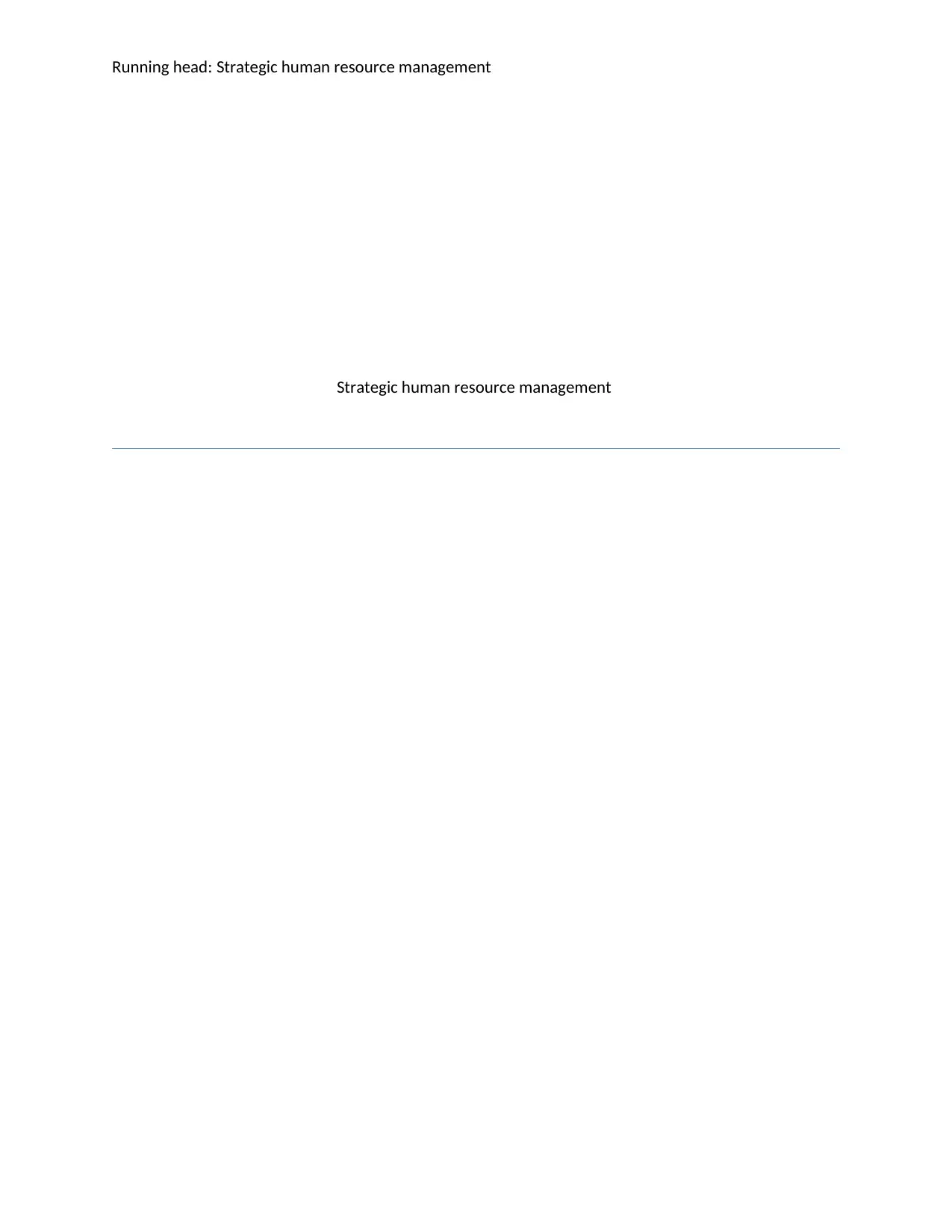
Running head: Strategic human resource management
Strategic human resource management
Strategic human resource management
Secure Best Marks with AI Grader
Need help grading? Try our AI Grader for instant feedback on your assignments.
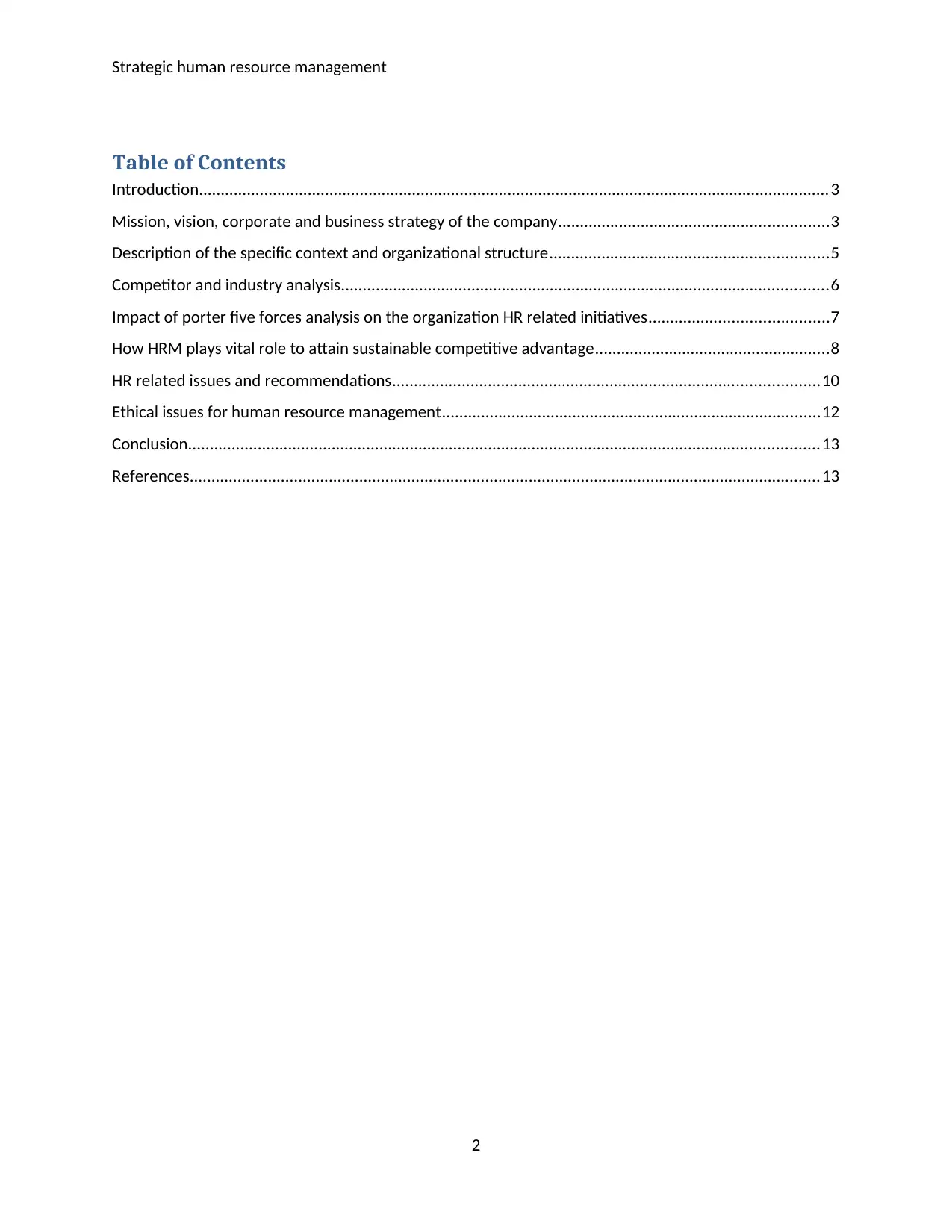
Strategic human resource management
Table of Contents
Introduction.................................................................................................................................................3
Mission, vision, corporate and business strategy of the company..............................................................3
Description of the specific context and organizational structure................................................................5
Competitor and industry analysis................................................................................................................6
Impact of porter five forces analysis on the organization HR related initiatives.........................................7
How HRM plays vital role to attain sustainable competitive advantage......................................................8
HR related issues and recommendations..................................................................................................10
Ethical issues for human resource management.......................................................................................12
Conclusion.................................................................................................................................................13
References.................................................................................................................................................13
2
Table of Contents
Introduction.................................................................................................................................................3
Mission, vision, corporate and business strategy of the company..............................................................3
Description of the specific context and organizational structure................................................................5
Competitor and industry analysis................................................................................................................6
Impact of porter five forces analysis on the organization HR related initiatives.........................................7
How HRM plays vital role to attain sustainable competitive advantage......................................................8
HR related issues and recommendations..................................................................................................10
Ethical issues for human resource management.......................................................................................12
Conclusion.................................................................................................................................................13
References.................................................................................................................................................13
2
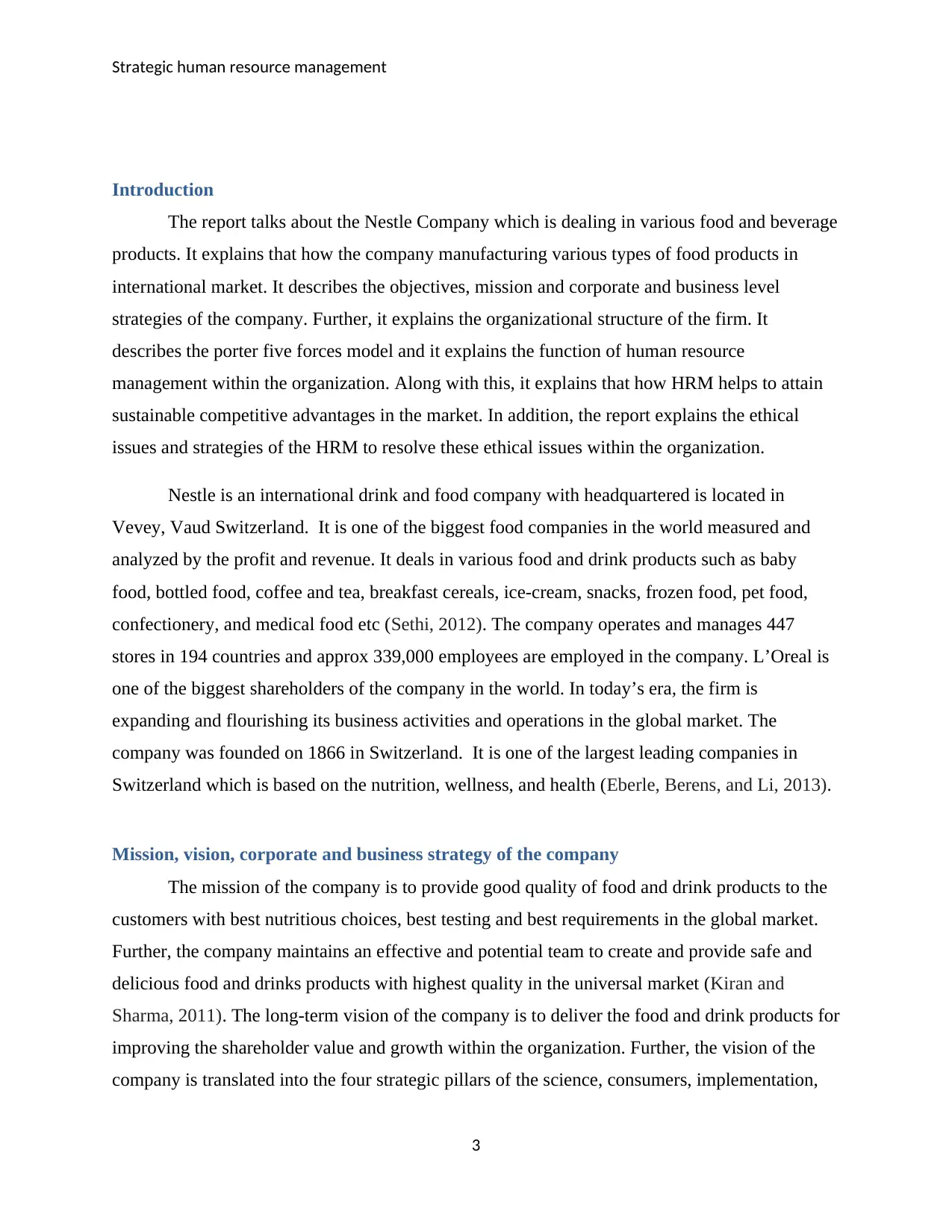
Strategic human resource management
Introduction
The report talks about the Nestle Company which is dealing in various food and beverage
products. It explains that how the company manufacturing various types of food products in
international market. It describes the objectives, mission and corporate and business level
strategies of the company. Further, it explains the organizational structure of the firm. It
describes the porter five forces model and it explains the function of human resource
management within the organization. Along with this, it explains that how HRM helps to attain
sustainable competitive advantages in the market. In addition, the report explains the ethical
issues and strategies of the HRM to resolve these ethical issues within the organization.
Nestle is an international drink and food company with headquartered is located in
Vevey, Vaud Switzerland. It is one of the biggest food companies in the world measured and
analyzed by the profit and revenue. It deals in various food and drink products such as baby
food, bottled food, coffee and tea, breakfast cereals, ice-cream, snacks, frozen food, pet food,
confectionery, and medical food etc (Sethi, 2012). The company operates and manages 447
stores in 194 countries and approx 339,000 employees are employed in the company. L’Oreal is
one of the biggest shareholders of the company in the world. In today’s era, the firm is
expanding and flourishing its business activities and operations in the global market. The
company was founded on 1866 in Switzerland. It is one of the largest leading companies in
Switzerland which is based on the nutrition, wellness, and health (Eberle, Berens, and Li, 2013).
Mission, vision, corporate and business strategy of the company
The mission of the company is to provide good quality of food and drink products to the
customers with best nutritious choices, best testing and best requirements in the global market.
Further, the company maintains an effective and potential team to create and provide safe and
delicious food and drinks products with highest quality in the universal market (Kiran and
Sharma, 2011). The long-term vision of the company is to deliver the food and drink products for
improving the shareholder value and growth within the organization. Further, the vision of the
company is translated into the four strategic pillars of the science, consumers, implementation,
3
Introduction
The report talks about the Nestle Company which is dealing in various food and beverage
products. It explains that how the company manufacturing various types of food products in
international market. It describes the objectives, mission and corporate and business level
strategies of the company. Further, it explains the organizational structure of the firm. It
describes the porter five forces model and it explains the function of human resource
management within the organization. Along with this, it explains that how HRM helps to attain
sustainable competitive advantages in the market. In addition, the report explains the ethical
issues and strategies of the HRM to resolve these ethical issues within the organization.
Nestle is an international drink and food company with headquartered is located in
Vevey, Vaud Switzerland. It is one of the biggest food companies in the world measured and
analyzed by the profit and revenue. It deals in various food and drink products such as baby
food, bottled food, coffee and tea, breakfast cereals, ice-cream, snacks, frozen food, pet food,
confectionery, and medical food etc (Sethi, 2012). The company operates and manages 447
stores in 194 countries and approx 339,000 employees are employed in the company. L’Oreal is
one of the biggest shareholders of the company in the world. In today’s era, the firm is
expanding and flourishing its business activities and operations in the global market. The
company was founded on 1866 in Switzerland. It is one of the largest leading companies in
Switzerland which is based on the nutrition, wellness, and health (Eberle, Berens, and Li, 2013).
Mission, vision, corporate and business strategy of the company
The mission of the company is to provide good quality of food and drink products to the
customers with best nutritious choices, best testing and best requirements in the global market.
Further, the company maintains an effective and potential team to create and provide safe and
delicious food and drinks products with highest quality in the universal market (Kiran and
Sharma, 2011). The long-term vision of the company is to deliver the food and drink products for
improving the shareholder value and growth within the organization. Further, the vision of the
company is translated into the four strategic pillars of the science, consumers, implementation,
3
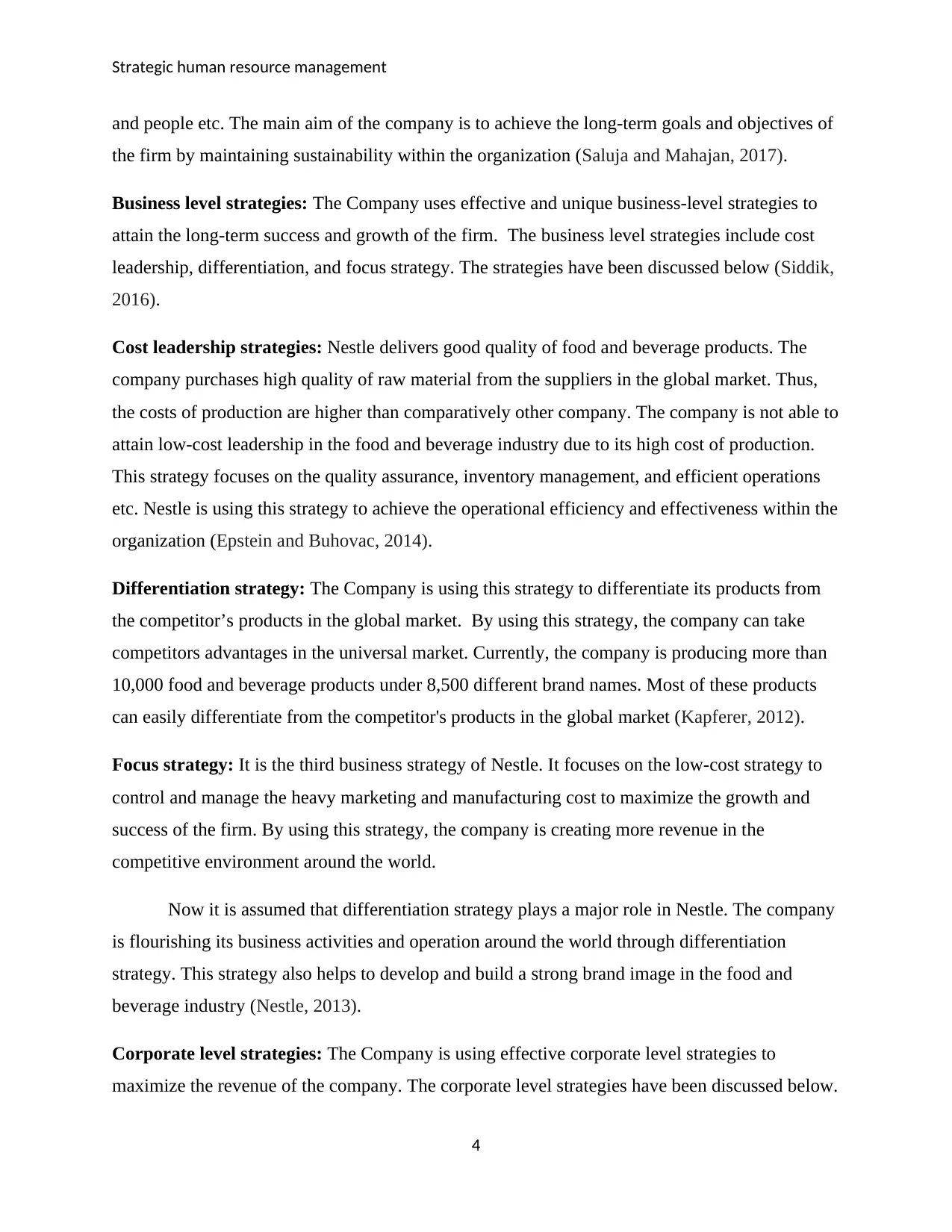
Strategic human resource management
and people etc. The main aim of the company is to achieve the long-term goals and objectives of
the firm by maintaining sustainability within the organization (Saluja and Mahajan, 2017).
Business level strategies: The Company uses effective and unique business-level strategies to
attain the long-term success and growth of the firm. The business level strategies include cost
leadership, differentiation, and focus strategy. The strategies have been discussed below (Siddik,
2016).
Cost leadership strategies: Nestle delivers good quality of food and beverage products. The
company purchases high quality of raw material from the suppliers in the global market. Thus,
the costs of production are higher than comparatively other company. The company is not able to
attain low-cost leadership in the food and beverage industry due to its high cost of production.
This strategy focuses on the quality assurance, inventory management, and efficient operations
etc. Nestle is using this strategy to achieve the operational efficiency and effectiveness within the
organization (Epstein and Buhovac, 2014).
Differentiation strategy: The Company is using this strategy to differentiate its products from
the competitor’s products in the global market. By using this strategy, the company can take
competitors advantages in the universal market. Currently, the company is producing more than
10,000 food and beverage products under 8,500 different brand names. Most of these products
can easily differentiate from the competitor's products in the global market (Kapferer, 2012).
Focus strategy: It is the third business strategy of Nestle. It focuses on the low-cost strategy to
control and manage the heavy marketing and manufacturing cost to maximize the growth and
success of the firm. By using this strategy, the company is creating more revenue in the
competitive environment around the world.
Now it is assumed that differentiation strategy plays a major role in Nestle. The company
is flourishing its business activities and operation around the world through differentiation
strategy. This strategy also helps to develop and build a strong brand image in the food and
beverage industry (Nestle, 2013).
Corporate level strategies: The Company is using effective corporate level strategies to
maximize the revenue of the company. The corporate level strategies have been discussed below.
4
and people etc. The main aim of the company is to achieve the long-term goals and objectives of
the firm by maintaining sustainability within the organization (Saluja and Mahajan, 2017).
Business level strategies: The Company uses effective and unique business-level strategies to
attain the long-term success and growth of the firm. The business level strategies include cost
leadership, differentiation, and focus strategy. The strategies have been discussed below (Siddik,
2016).
Cost leadership strategies: Nestle delivers good quality of food and beverage products. The
company purchases high quality of raw material from the suppliers in the global market. Thus,
the costs of production are higher than comparatively other company. The company is not able to
attain low-cost leadership in the food and beverage industry due to its high cost of production.
This strategy focuses on the quality assurance, inventory management, and efficient operations
etc. Nestle is using this strategy to achieve the operational efficiency and effectiveness within the
organization (Epstein and Buhovac, 2014).
Differentiation strategy: The Company is using this strategy to differentiate its products from
the competitor’s products in the global market. By using this strategy, the company can take
competitors advantages in the universal market. Currently, the company is producing more than
10,000 food and beverage products under 8,500 different brand names. Most of these products
can easily differentiate from the competitor's products in the global market (Kapferer, 2012).
Focus strategy: It is the third business strategy of Nestle. It focuses on the low-cost strategy to
control and manage the heavy marketing and manufacturing cost to maximize the growth and
success of the firm. By using this strategy, the company is creating more revenue in the
competitive environment around the world.
Now it is assumed that differentiation strategy plays a major role in Nestle. The company
is flourishing its business activities and operation around the world through differentiation
strategy. This strategy also helps to develop and build a strong brand image in the food and
beverage industry (Nestle, 2013).
Corporate level strategies: The Company is using effective corporate level strategies to
maximize the revenue of the company. The corporate level strategies have been discussed below.
4
Secure Best Marks with AI Grader
Need help grading? Try our AI Grader for instant feedback on your assignments.
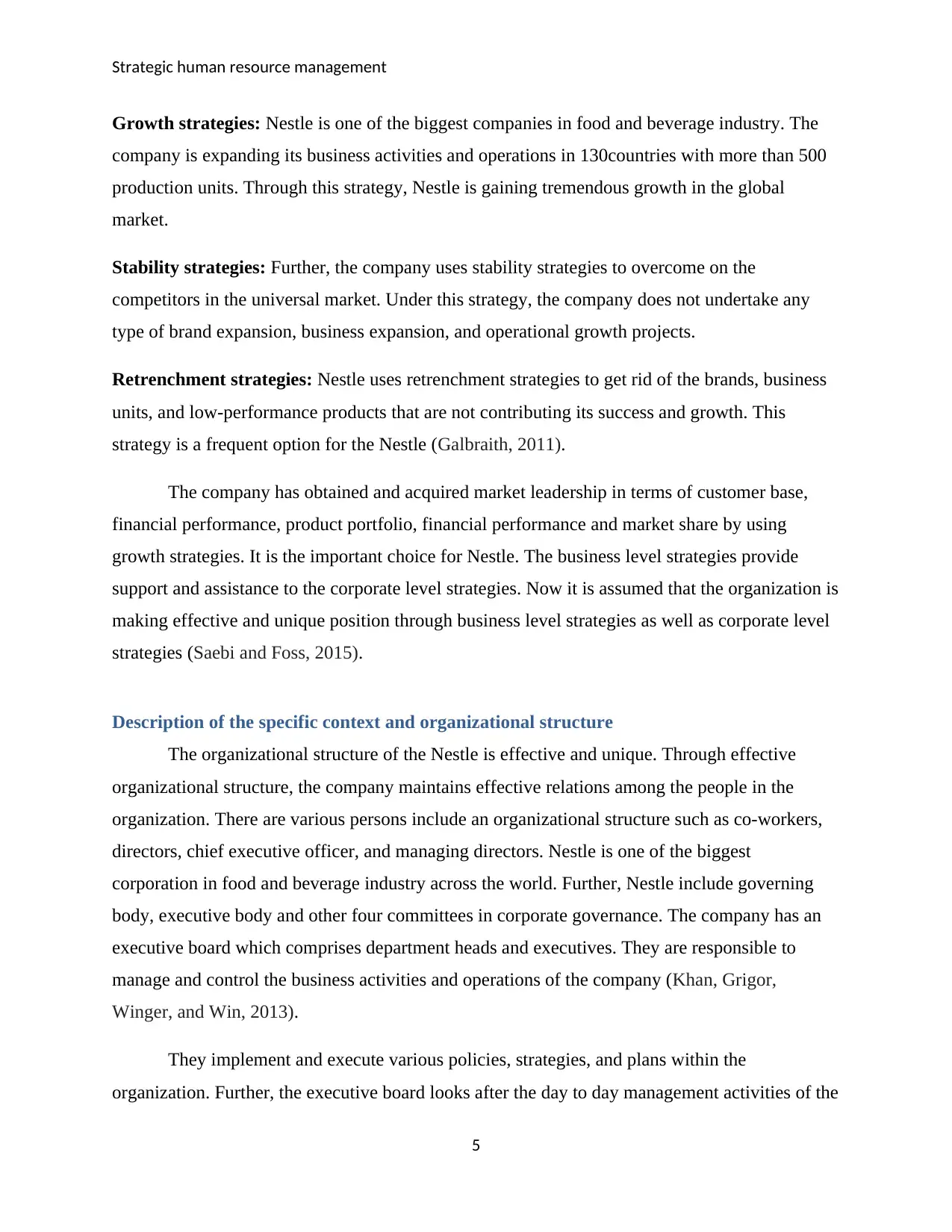
Strategic human resource management
Growth strategies: Nestle is one of the biggest companies in food and beverage industry. The
company is expanding its business activities and operations in 130countries with more than 500
production units. Through this strategy, Nestle is gaining tremendous growth in the global
market.
Stability strategies: Further, the company uses stability strategies to overcome on the
competitors in the universal market. Under this strategy, the company does not undertake any
type of brand expansion, business expansion, and operational growth projects.
Retrenchment strategies: Nestle uses retrenchment strategies to get rid of the brands, business
units, and low-performance products that are not contributing its success and growth. This
strategy is a frequent option for the Nestle (Galbraith, 2011).
The company has obtained and acquired market leadership in terms of customer base,
financial performance, product portfolio, financial performance and market share by using
growth strategies. It is the important choice for Nestle. The business level strategies provide
support and assistance to the corporate level strategies. Now it is assumed that the organization is
making effective and unique position through business level strategies as well as corporate level
strategies (Saebi and Foss, 2015).
Description of the specific context and organizational structure
The organizational structure of the Nestle is effective and unique. Through effective
organizational structure, the company maintains effective relations among the people in the
organization. There are various persons include an organizational structure such as co-workers,
directors, chief executive officer, and managing directors. Nestle is one of the biggest
corporation in food and beverage industry across the world. Further, Nestle include governing
body, executive body and other four committees in corporate governance. The company has an
executive board which comprises department heads and executives. They are responsible to
manage and control the business activities and operations of the company (Khan, Grigor,
Winger, and Win, 2013).
They implement and execute various policies, strategies, and plans within the
organization. Further, the executive board looks after the day to day management activities of the
5
Growth strategies: Nestle is one of the biggest companies in food and beverage industry. The
company is expanding its business activities and operations in 130countries with more than 500
production units. Through this strategy, Nestle is gaining tremendous growth in the global
market.
Stability strategies: Further, the company uses stability strategies to overcome on the
competitors in the universal market. Under this strategy, the company does not undertake any
type of brand expansion, business expansion, and operational growth projects.
Retrenchment strategies: Nestle uses retrenchment strategies to get rid of the brands, business
units, and low-performance products that are not contributing its success and growth. This
strategy is a frequent option for the Nestle (Galbraith, 2011).
The company has obtained and acquired market leadership in terms of customer base,
financial performance, product portfolio, financial performance and market share by using
growth strategies. It is the important choice for Nestle. The business level strategies provide
support and assistance to the corporate level strategies. Now it is assumed that the organization is
making effective and unique position through business level strategies as well as corporate level
strategies (Saebi and Foss, 2015).
Description of the specific context and organizational structure
The organizational structure of the Nestle is effective and unique. Through effective
organizational structure, the company maintains effective relations among the people in the
organization. There are various persons include an organizational structure such as co-workers,
directors, chief executive officer, and managing directors. Nestle is one of the biggest
corporation in food and beverage industry across the world. Further, Nestle include governing
body, executive body and other four committees in corporate governance. The company has an
executive board which comprises department heads and executives. They are responsible to
manage and control the business activities and operations of the company (Khan, Grigor,
Winger, and Win, 2013).
They implement and execute various policies, strategies, and plans within the
organization. Further, the executive board looks after the day to day management activities of the
5
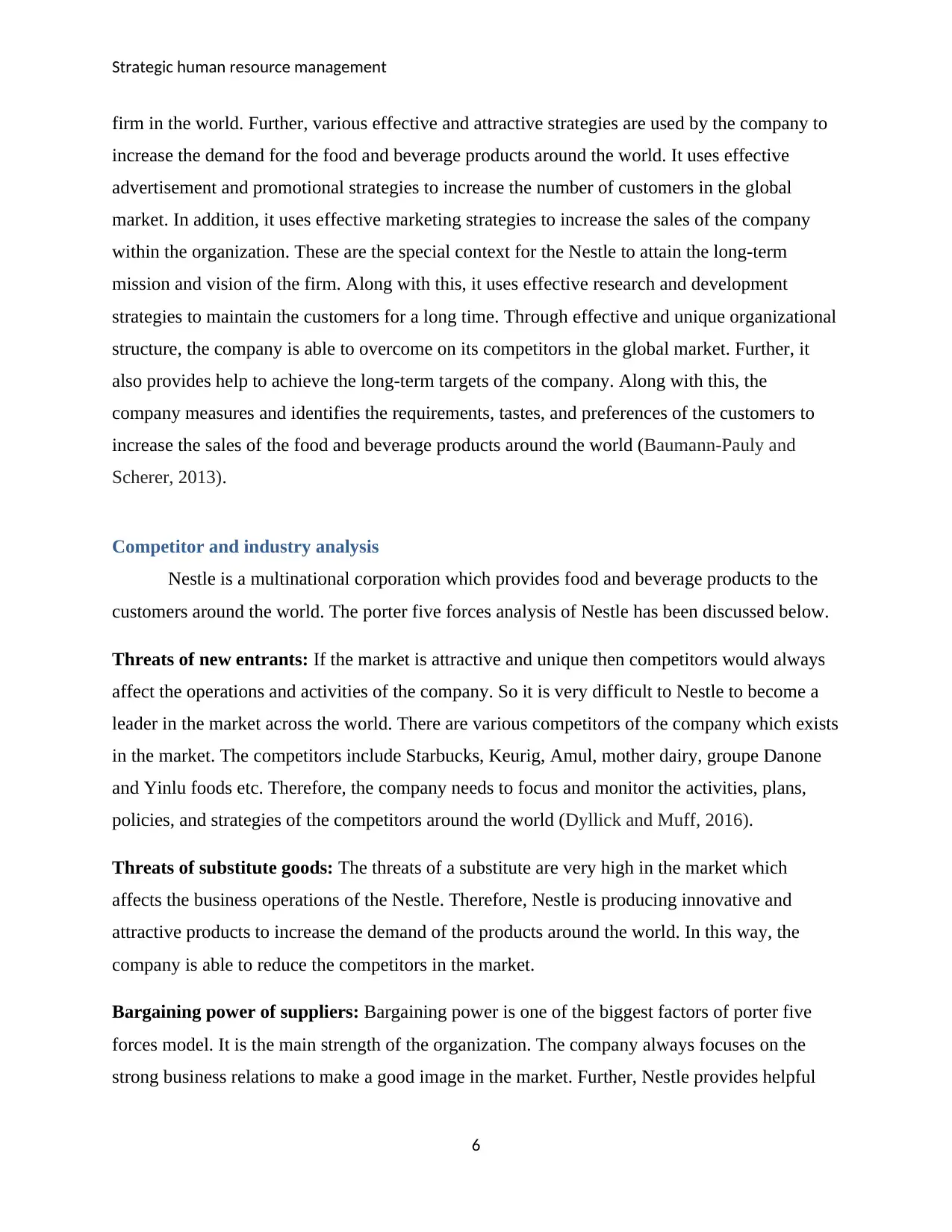
Strategic human resource management
firm in the world. Further, various effective and attractive strategies are used by the company to
increase the demand for the food and beverage products around the world. It uses effective
advertisement and promotional strategies to increase the number of customers in the global
market. In addition, it uses effective marketing strategies to increase the sales of the company
within the organization. These are the special context for the Nestle to attain the long-term
mission and vision of the firm. Along with this, it uses effective research and development
strategies to maintain the customers for a long time. Through effective and unique organizational
structure, the company is able to overcome on its competitors in the global market. Further, it
also provides help to achieve the long-term targets of the company. Along with this, the
company measures and identifies the requirements, tastes, and preferences of the customers to
increase the sales of the food and beverage products around the world (Baumann-Pauly and
Scherer, 2013).
Competitor and industry analysis
Nestle is a multinational corporation which provides food and beverage products to the
customers around the world. The porter five forces analysis of Nestle has been discussed below.
Threats of new entrants: If the market is attractive and unique then competitors would always
affect the operations and activities of the company. So it is very difficult to Nestle to become a
leader in the market across the world. There are various competitors of the company which exists
in the market. The competitors include Starbucks, Keurig, Amul, mother dairy, groupe Danone
and Yinlu foods etc. Therefore, the company needs to focus and monitor the activities, plans,
policies, and strategies of the competitors around the world (Dyllick and Muff, 2016).
Threats of substitute goods: The threats of a substitute are very high in the market which
affects the business operations of the Nestle. Therefore, Nestle is producing innovative and
attractive products to increase the demand of the products around the world. In this way, the
company is able to reduce the competitors in the market.
Bargaining power of suppliers: Bargaining power is one of the biggest factors of porter five
forces model. It is the main strength of the organization. The company always focuses on the
strong business relations to make a good image in the market. Further, Nestle provides helpful
6
firm in the world. Further, various effective and attractive strategies are used by the company to
increase the demand for the food and beverage products around the world. It uses effective
advertisement and promotional strategies to increase the number of customers in the global
market. In addition, it uses effective marketing strategies to increase the sales of the company
within the organization. These are the special context for the Nestle to attain the long-term
mission and vision of the firm. Along with this, it uses effective research and development
strategies to maintain the customers for a long time. Through effective and unique organizational
structure, the company is able to overcome on its competitors in the global market. Further, it
also provides help to achieve the long-term targets of the company. Along with this, the
company measures and identifies the requirements, tastes, and preferences of the customers to
increase the sales of the food and beverage products around the world (Baumann-Pauly and
Scherer, 2013).
Competitor and industry analysis
Nestle is a multinational corporation which provides food and beverage products to the
customers around the world. The porter five forces analysis of Nestle has been discussed below.
Threats of new entrants: If the market is attractive and unique then competitors would always
affect the operations and activities of the company. So it is very difficult to Nestle to become a
leader in the market across the world. There are various competitors of the company which exists
in the market. The competitors include Starbucks, Keurig, Amul, mother dairy, groupe Danone
and Yinlu foods etc. Therefore, the company needs to focus and monitor the activities, plans,
policies, and strategies of the competitors around the world (Dyllick and Muff, 2016).
Threats of substitute goods: The threats of a substitute are very high in the market which
affects the business operations of the Nestle. Therefore, Nestle is producing innovative and
attractive products to increase the demand of the products around the world. In this way, the
company is able to reduce the competitors in the market.
Bargaining power of suppliers: Bargaining power is one of the biggest factors of porter five
forces model. It is the main strength of the organization. The company always focuses on the
strong business relations to make a good image in the market. Further, Nestle provides helpful
6

Strategic human resource management
guidance and support to its suppliers to do work effectively and efficiently (Gold and
Heikkurinen, 2013).
Bargaining power of customers: It is an important factor to which affect the growth and
success of the company. It is essential to understand and evaluate the power of customers and
their needs, requirements, and expectations so that they can be satisfied.
Competitive rivalry within the industry: There are various competitors exist in the market that
affects the success of the organization. Nestle company maintains a strong position in food and
beverage industry. There are various competitors exist in the food and beverage industry such as
Groupe Danone and Kraft foods, therefore, the company needs to focus on the plans, strategies,
and policies within the organization (Stampfl and Prügl, 2011).
Further, the company can use pestle analysis to determine and evaluate the external
environment of the company. Pestle stands for political, economic, socio-cultural, legal factors
and environmental factors etc. Through pestle analysis, Nestle can find and evaluate the
microenvironment of the country. It will also help to reduce and control over the key challenges
of the global market in the world. It will also help to evaluate and analyze the economy of the
country. Along with this, the company can use SWOT analysis to evaluate the strengths,
weaknesses, opportunities, and threats of the company. In this way, the company can overcome
on the competitors in the market (Sakunia and Jha, 2016).
Impact of porter five forces analysis on the organization HR related initiatives
There are the various impact of porter five forces analysis on the organizational human
resource management. Porter five forces model helps to analyze and evaluate the enormous
competitors in the market. Human resource management can easily reach its targets within the
organization. It also helps to determine and identify the intensity and strengths of the competition
in the global market. Further, it will also help to provide various competitor benefits in the global
world. Porter five forces model also provide assistance to the HRM to attract more applicants in
the universal market. It is useful to make a good and attractive image around the world. HRM
can use this model as a statistical tool to determine and measure the attractiveness of the Nestle
industry. Through this model, the company can take important decision related to the market
segment. It also provides flexibility and transparency to the HR department within the
7
guidance and support to its suppliers to do work effectively and efficiently (Gold and
Heikkurinen, 2013).
Bargaining power of customers: It is an important factor to which affect the growth and
success of the company. It is essential to understand and evaluate the power of customers and
their needs, requirements, and expectations so that they can be satisfied.
Competitive rivalry within the industry: There are various competitors exist in the market that
affects the success of the organization. Nestle company maintains a strong position in food and
beverage industry. There are various competitors exist in the food and beverage industry such as
Groupe Danone and Kraft foods, therefore, the company needs to focus on the plans, strategies,
and policies within the organization (Stampfl and Prügl, 2011).
Further, the company can use pestle analysis to determine and evaluate the external
environment of the company. Pestle stands for political, economic, socio-cultural, legal factors
and environmental factors etc. Through pestle analysis, Nestle can find and evaluate the
microenvironment of the country. It will also help to reduce and control over the key challenges
of the global market in the world. It will also help to evaluate and analyze the economy of the
country. Along with this, the company can use SWOT analysis to evaluate the strengths,
weaknesses, opportunities, and threats of the company. In this way, the company can overcome
on the competitors in the market (Sakunia and Jha, 2016).
Impact of porter five forces analysis on the organization HR related initiatives
There are the various impact of porter five forces analysis on the organizational human
resource management. Porter five forces model helps to analyze and evaluate the enormous
competitors in the market. Human resource management can easily reach its targets within the
organization. It also helps to determine and identify the intensity and strengths of the competition
in the global market. Further, it will also help to provide various competitor benefits in the global
world. Porter five forces model also provide assistance to the HRM to attract more applicants in
the universal market. It is useful to make a good and attractive image around the world. HRM
can use this model as a statistical tool to determine and measure the attractiveness of the Nestle
industry. Through this model, the company can take important decision related to the market
segment. It also provides flexibility and transparency to the HR department within the
7
Paraphrase This Document
Need a fresh take? Get an instant paraphrase of this document with our AI Paraphraser
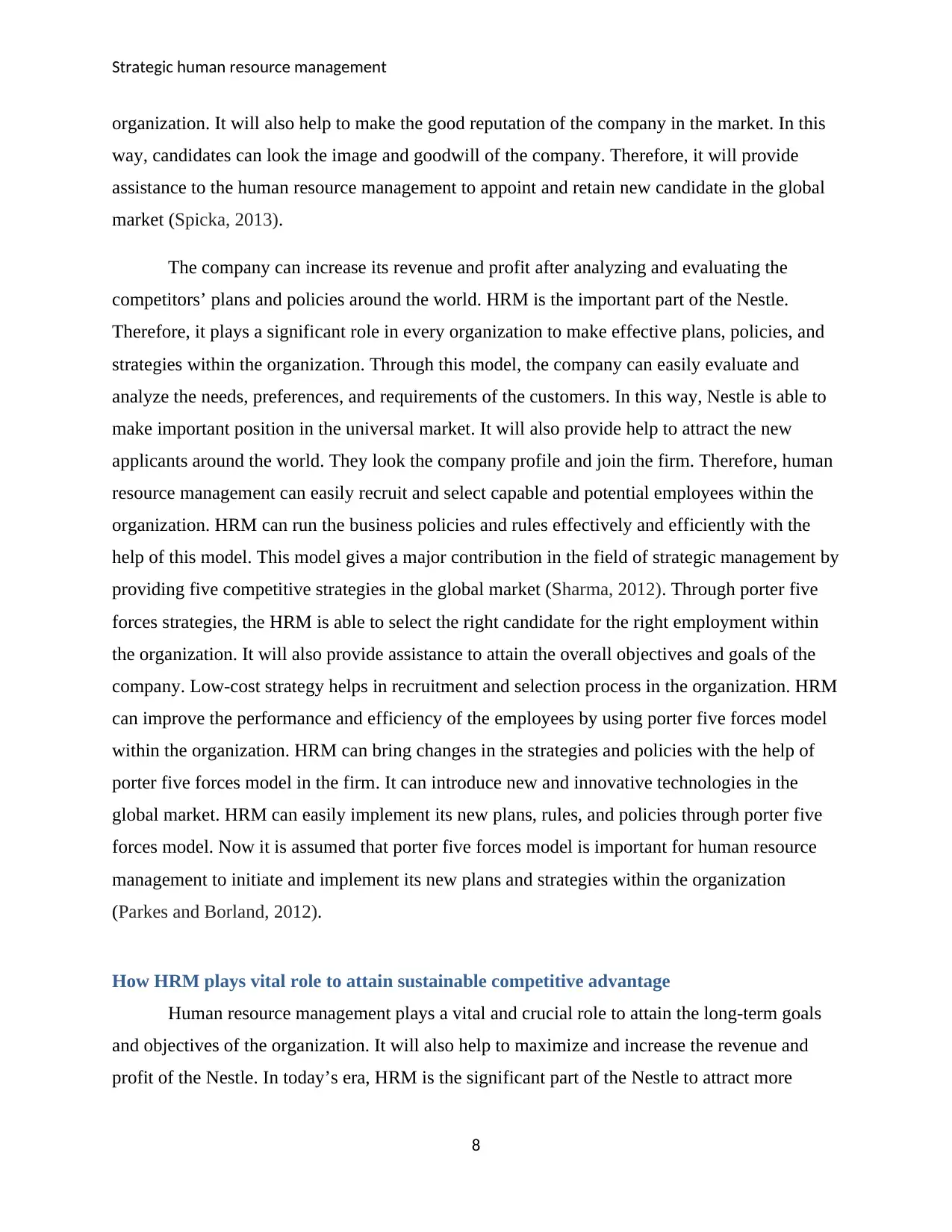
Strategic human resource management
organization. It will also help to make the good reputation of the company in the market. In this
way, candidates can look the image and goodwill of the company. Therefore, it will provide
assistance to the human resource management to appoint and retain new candidate in the global
market (Spicka, 2013).
The company can increase its revenue and profit after analyzing and evaluating the
competitors’ plans and policies around the world. HRM is the important part of the Nestle.
Therefore, it plays a significant role in every organization to make effective plans, policies, and
strategies within the organization. Through this model, the company can easily evaluate and
analyze the needs, preferences, and requirements of the customers. In this way, Nestle is able to
make important position in the universal market. It will also provide help to attract the new
applicants around the world. They look the company profile and join the firm. Therefore, human
resource management can easily recruit and select capable and potential employees within the
organization. HRM can run the business policies and rules effectively and efficiently with the
help of this model. This model gives a major contribution in the field of strategic management by
providing five competitive strategies in the global market (Sharma, 2012). Through porter five
forces strategies, the HRM is able to select the right candidate for the right employment within
the organization. It will also provide assistance to attain the overall objectives and goals of the
company. Low-cost strategy helps in recruitment and selection process in the organization. HRM
can improve the performance and efficiency of the employees by using porter five forces model
within the organization. HRM can bring changes in the strategies and policies with the help of
porter five forces model in the firm. It can introduce new and innovative technologies in the
global market. HRM can easily implement its new plans, rules, and policies through porter five
forces model. Now it is assumed that porter five forces model is important for human resource
management to initiate and implement its new plans and strategies within the organization
(Parkes and Borland, 2012).
How HRM plays vital role to attain sustainable competitive advantage
Human resource management plays a vital and crucial role to attain the long-term goals
and objectives of the organization. It will also help to maximize and increase the revenue and
profit of the Nestle. In today’s era, HRM is the significant part of the Nestle to attract more
8
organization. It will also help to make the good reputation of the company in the market. In this
way, candidates can look the image and goodwill of the company. Therefore, it will provide
assistance to the human resource management to appoint and retain new candidate in the global
market (Spicka, 2013).
The company can increase its revenue and profit after analyzing and evaluating the
competitors’ plans and policies around the world. HRM is the important part of the Nestle.
Therefore, it plays a significant role in every organization to make effective plans, policies, and
strategies within the organization. Through this model, the company can easily evaluate and
analyze the needs, preferences, and requirements of the customers. In this way, Nestle is able to
make important position in the universal market. It will also provide help to attract the new
applicants around the world. They look the company profile and join the firm. Therefore, human
resource management can easily recruit and select capable and potential employees within the
organization. HRM can run the business policies and rules effectively and efficiently with the
help of this model. This model gives a major contribution in the field of strategic management by
providing five competitive strategies in the global market (Sharma, 2012). Through porter five
forces strategies, the HRM is able to select the right candidate for the right employment within
the organization. It will also provide assistance to attain the overall objectives and goals of the
company. Low-cost strategy helps in recruitment and selection process in the organization. HRM
can improve the performance and efficiency of the employees by using porter five forces model
within the organization. HRM can bring changes in the strategies and policies with the help of
porter five forces model in the firm. It can introduce new and innovative technologies in the
global market. HRM can easily implement its new plans, rules, and policies through porter five
forces model. Now it is assumed that porter five forces model is important for human resource
management to initiate and implement its new plans and strategies within the organization
(Parkes and Borland, 2012).
How HRM plays vital role to attain sustainable competitive advantage
Human resource management plays a vital and crucial role to attain the long-term goals
and objectives of the organization. It will also help to maximize and increase the revenue and
profit of the Nestle. In today’s era, HRM is the significant part of the Nestle to attract more
8

Strategic human resource management
candidates in the market. There are various role of human resource management in the global
market which have discussed below (Mohajan, 2015).
Value: HRM provides worth to the employees in the organization and it shows a good value for
the firm. In this way, human resource management helps to attain the sustainability and it
provides effective competitive advantages in the market by creating value and worth around the
world.
Rareness: Only value cannot help to the human resource department to gain the sustainable
competitive benefits in the universal market. HR team should examine and evaluate the policies
and plans of the competitors across the world. HRM evaluates and measures the rare and other
risk factors in the talent management. In this way, the company can overcome on its competitors
in the market (Li, 2015).
Imitability: HRM develops and builds effective policies and plans to overcome on the
competitors around the world. They help to develop and build a unique culture within the
organization.
Organization: HRM organizing and modify the various rules, policies, and strategies of the
organization to prevent the risk and challenges of the market and to attract more customers
within the organization (Cerdin and Brewster, 2014).
Recruitment and selection: Human resource management recruits and selects suitable and
appropriate candidates in the market. It is the major function of HRM to make a good image
around the world. The company appoints skilled and potential applicants to overcome on the
competitors in the universal market. If the company makes effective and unique recruitment and
selection process then it can provide various advantages in the market. It reduces the high
employee’s turnover within the organization. Therefore, it will increase the revenue and profit of
the firm (Stahl et al, 2012).
Rewards and compensation system: HRM plays a vital role in rewards and compensation
system to gain the competitive advantages in the international market. HRM provides rewards
and incentives to the potential and capable employees for improving their efficiency and
9
candidates in the market. There are various role of human resource management in the global
market which have discussed below (Mohajan, 2015).
Value: HRM provides worth to the employees in the organization and it shows a good value for
the firm. In this way, human resource management helps to attain the sustainability and it
provides effective competitive advantages in the market by creating value and worth around the
world.
Rareness: Only value cannot help to the human resource department to gain the sustainable
competitive benefits in the universal market. HR team should examine and evaluate the policies
and plans of the competitors across the world. HRM evaluates and measures the rare and other
risk factors in the talent management. In this way, the company can overcome on its competitors
in the market (Li, 2015).
Imitability: HRM develops and builds effective policies and plans to overcome on the
competitors around the world. They help to develop and build a unique culture within the
organization.
Organization: HRM organizing and modify the various rules, policies, and strategies of the
organization to prevent the risk and challenges of the market and to attract more customers
within the organization (Cerdin and Brewster, 2014).
Recruitment and selection: Human resource management recruits and selects suitable and
appropriate candidates in the market. It is the major function of HRM to make a good image
around the world. The company appoints skilled and potential applicants to overcome on the
competitors in the universal market. If the company makes effective and unique recruitment and
selection process then it can provide various advantages in the market. It reduces the high
employee’s turnover within the organization. Therefore, it will increase the revenue and profit of
the firm (Stahl et al, 2012).
Rewards and compensation system: HRM plays a vital role in rewards and compensation
system to gain the competitive advantages in the international market. HRM provides rewards
and incentives to the potential and capable employees for improving their efficiency and
9
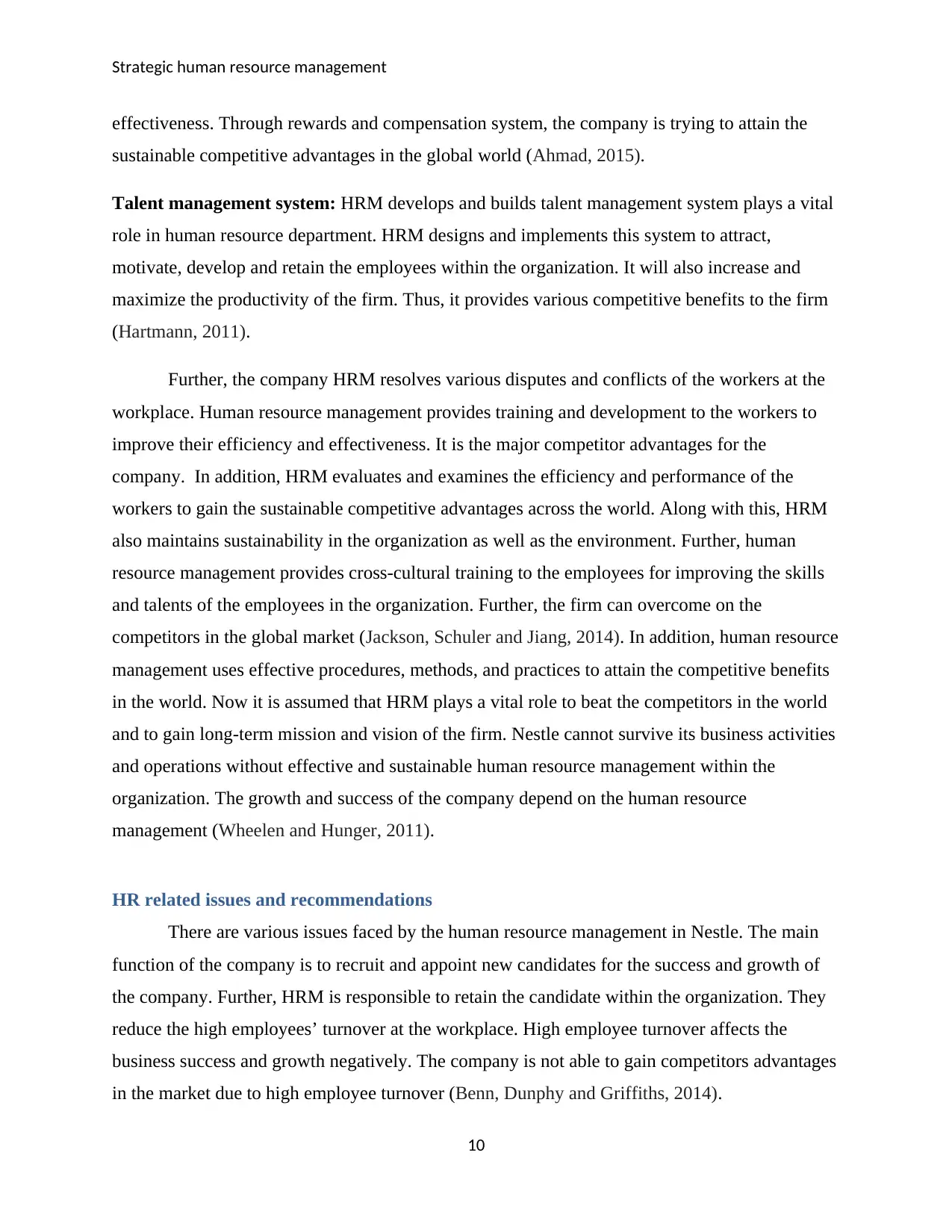
Strategic human resource management
effectiveness. Through rewards and compensation system, the company is trying to attain the
sustainable competitive advantages in the global world (Ahmad, 2015).
Talent management system: HRM develops and builds talent management system plays a vital
role in human resource department. HRM designs and implements this system to attract,
motivate, develop and retain the employees within the organization. It will also increase and
maximize the productivity of the firm. Thus, it provides various competitive benefits to the firm
(Hartmann, 2011).
Further, the company HRM resolves various disputes and conflicts of the workers at the
workplace. Human resource management provides training and development to the workers to
improve their efficiency and effectiveness. It is the major competitor advantages for the
company. In addition, HRM evaluates and examines the efficiency and performance of the
workers to gain the sustainable competitive advantages across the world. Along with this, HRM
also maintains sustainability in the organization as well as the environment. Further, human
resource management provides cross-cultural training to the employees for improving the skills
and talents of the employees in the organization. Further, the firm can overcome on the
competitors in the global market (Jackson, Schuler and Jiang, 2014). In addition, human resource
management uses effective procedures, methods, and practices to attain the competitive benefits
in the world. Now it is assumed that HRM plays a vital role to beat the competitors in the world
and to gain long-term mission and vision of the firm. Nestle cannot survive its business activities
and operations without effective and sustainable human resource management within the
organization. The growth and success of the company depend on the human resource
management (Wheelen and Hunger, 2011).
HR related issues and recommendations
There are various issues faced by the human resource management in Nestle. The main
function of the company is to recruit and appoint new candidates for the success and growth of
the company. Further, HRM is responsible to retain the candidate within the organization. They
reduce the high employees’ turnover at the workplace. High employee turnover affects the
business success and growth negatively. The company is not able to gain competitors advantages
in the market due to high employee turnover (Benn, Dunphy and Griffiths, 2014).
10
effectiveness. Through rewards and compensation system, the company is trying to attain the
sustainable competitive advantages in the global world (Ahmad, 2015).
Talent management system: HRM develops and builds talent management system plays a vital
role in human resource department. HRM designs and implements this system to attract,
motivate, develop and retain the employees within the organization. It will also increase and
maximize the productivity of the firm. Thus, it provides various competitive benefits to the firm
(Hartmann, 2011).
Further, the company HRM resolves various disputes and conflicts of the workers at the
workplace. Human resource management provides training and development to the workers to
improve their efficiency and effectiveness. It is the major competitor advantages for the
company. In addition, HRM evaluates and examines the efficiency and performance of the
workers to gain the sustainable competitive advantages across the world. Along with this, HRM
also maintains sustainability in the organization as well as the environment. Further, human
resource management provides cross-cultural training to the employees for improving the skills
and talents of the employees in the organization. Further, the firm can overcome on the
competitors in the global market (Jackson, Schuler and Jiang, 2014). In addition, human resource
management uses effective procedures, methods, and practices to attain the competitive benefits
in the world. Now it is assumed that HRM plays a vital role to beat the competitors in the world
and to gain long-term mission and vision of the firm. Nestle cannot survive its business activities
and operations without effective and sustainable human resource management within the
organization. The growth and success of the company depend on the human resource
management (Wheelen and Hunger, 2011).
HR related issues and recommendations
There are various issues faced by the human resource management in Nestle. The main
function of the company is to recruit and appoint new candidates for the success and growth of
the company. Further, HRM is responsible to retain the candidate within the organization. They
reduce the high employees’ turnover at the workplace. High employee turnover affects the
business success and growth negatively. The company is not able to gain competitors advantages
in the market due to high employee turnover (Benn, Dunphy and Griffiths, 2014).
10
Secure Best Marks with AI Grader
Need help grading? Try our AI Grader for instant feedback on your assignments.
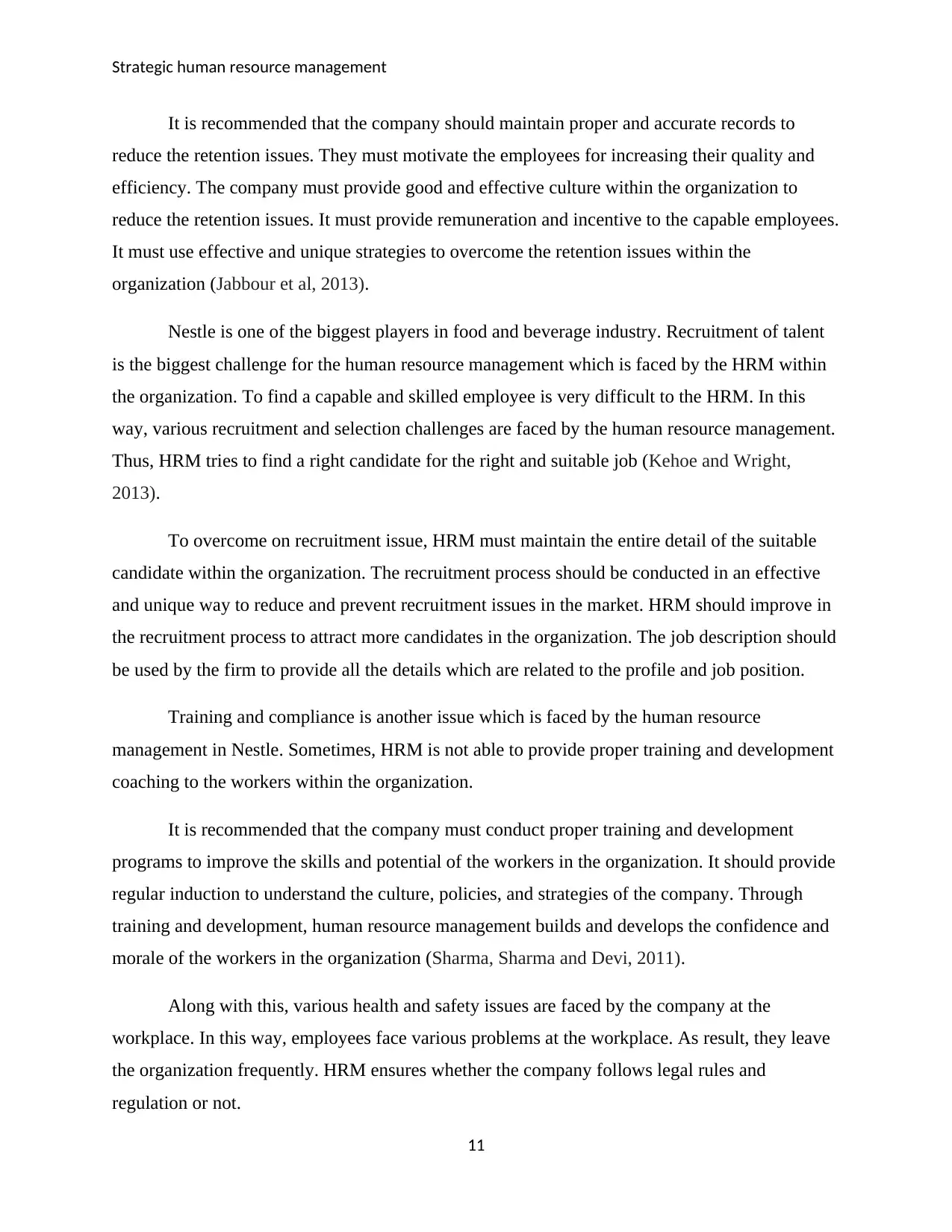
Strategic human resource management
It is recommended that the company should maintain proper and accurate records to
reduce the retention issues. They must motivate the employees for increasing their quality and
efficiency. The company must provide good and effective culture within the organization to
reduce the retention issues. It must provide remuneration and incentive to the capable employees.
It must use effective and unique strategies to overcome the retention issues within the
organization (Jabbour et al, 2013).
Nestle is one of the biggest players in food and beverage industry. Recruitment of talent
is the biggest challenge for the human resource management which is faced by the HRM within
the organization. To find a capable and skilled employee is very difficult to the HRM. In this
way, various recruitment and selection challenges are faced by the human resource management.
Thus, HRM tries to find a right candidate for the right and suitable job (Kehoe and Wright,
2013).
To overcome on recruitment issue, HRM must maintain the entire detail of the suitable
candidate within the organization. The recruitment process should be conducted in an effective
and unique way to reduce and prevent recruitment issues in the market. HRM should improve in
the recruitment process to attract more candidates in the organization. The job description should
be used by the firm to provide all the details which are related to the profile and job position.
Training and compliance is another issue which is faced by the human resource
management in Nestle. Sometimes, HRM is not able to provide proper training and development
coaching to the workers within the organization.
It is recommended that the company must conduct proper training and development
programs to improve the skills and potential of the workers in the organization. It should provide
regular induction to understand the culture, policies, and strategies of the company. Through
training and development, human resource management builds and develops the confidence and
morale of the workers in the organization (Sharma, Sharma and Devi, 2011).
Along with this, various health and safety issues are faced by the company at the
workplace. In this way, employees face various problems at the workplace. As result, they leave
the organization frequently. HRM ensures whether the company follows legal rules and
regulation or not.
11
It is recommended that the company should maintain proper and accurate records to
reduce the retention issues. They must motivate the employees for increasing their quality and
efficiency. The company must provide good and effective culture within the organization to
reduce the retention issues. It must provide remuneration and incentive to the capable employees.
It must use effective and unique strategies to overcome the retention issues within the
organization (Jabbour et al, 2013).
Nestle is one of the biggest players in food and beverage industry. Recruitment of talent
is the biggest challenge for the human resource management which is faced by the HRM within
the organization. To find a capable and skilled employee is very difficult to the HRM. In this
way, various recruitment and selection challenges are faced by the human resource management.
Thus, HRM tries to find a right candidate for the right and suitable job (Kehoe and Wright,
2013).
To overcome on recruitment issue, HRM must maintain the entire detail of the suitable
candidate within the organization. The recruitment process should be conducted in an effective
and unique way to reduce and prevent recruitment issues in the market. HRM should improve in
the recruitment process to attract more candidates in the organization. The job description should
be used by the firm to provide all the details which are related to the profile and job position.
Training and compliance is another issue which is faced by the human resource
management in Nestle. Sometimes, HRM is not able to provide proper training and development
coaching to the workers within the organization.
It is recommended that the company must conduct proper training and development
programs to improve the skills and potential of the workers in the organization. It should provide
regular induction to understand the culture, policies, and strategies of the company. Through
training and development, human resource management builds and develops the confidence and
morale of the workers in the organization (Sharma, Sharma and Devi, 2011).
Along with this, various health and safety issues are faced by the company at the
workplace. In this way, employees face various problems at the workplace. As result, they leave
the organization frequently. HRM ensures whether the company follows legal rules and
regulation or not.
11
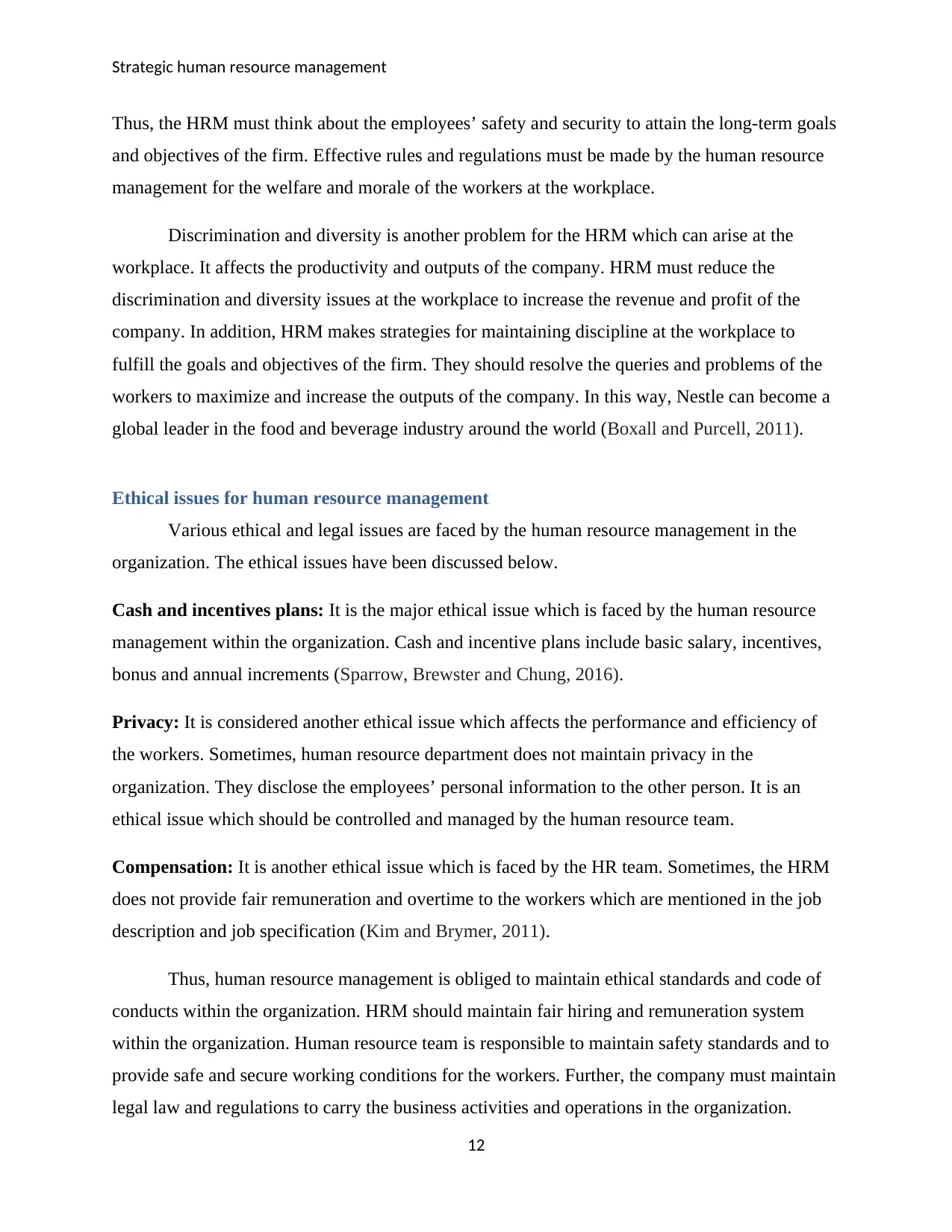
Strategic human resource management
Thus, the HRM must think about the employees’ safety and security to attain the long-term goals
and objectives of the firm. Effective rules and regulations must be made by the human resource
management for the welfare and morale of the workers at the workplace.
Discrimination and diversity is another problem for the HRM which can arise at the
workplace. It affects the productivity and outputs of the company. HRM must reduce the
discrimination and diversity issues at the workplace to increase the revenue and profit of the
company. In addition, HRM makes strategies for maintaining discipline at the workplace to
fulfill the goals and objectives of the firm. They should resolve the queries and problems of the
workers to maximize and increase the outputs of the company. In this way, Nestle can become a
global leader in the food and beverage industry around the world (Boxall and Purcell, 2011).
Ethical issues for human resource management
Various ethical and legal issues are faced by the human resource management in the
organization. The ethical issues have been discussed below.
Cash and incentives plans: It is the major ethical issue which is faced by the human resource
management within the organization. Cash and incentive plans include basic salary, incentives,
bonus and annual increments (Sparrow, Brewster and Chung, 2016).
Privacy: It is considered another ethical issue which affects the performance and efficiency of
the workers. Sometimes, human resource department does not maintain privacy in the
organization. They disclose the employees’ personal information to the other person. It is an
ethical issue which should be controlled and managed by the human resource team.
Compensation: It is another ethical issue which is faced by the HR team. Sometimes, the HRM
does not provide fair remuneration and overtime to the workers which are mentioned in the job
description and job specification (Kim and Brymer, 2011).
Thus, human resource management is obliged to maintain ethical standards and code of
conducts within the organization. HRM should maintain fair hiring and remuneration system
within the organization. Human resource team is responsible to maintain safety standards and to
provide safe and secure working conditions for the workers. Further, the company must maintain
legal law and regulations to carry the business activities and operations in the organization.
12
Thus, the HRM must think about the employees’ safety and security to attain the long-term goals
and objectives of the firm. Effective rules and regulations must be made by the human resource
management for the welfare and morale of the workers at the workplace.
Discrimination and diversity is another problem for the HRM which can arise at the
workplace. It affects the productivity and outputs of the company. HRM must reduce the
discrimination and diversity issues at the workplace to increase the revenue and profit of the
company. In addition, HRM makes strategies for maintaining discipline at the workplace to
fulfill the goals and objectives of the firm. They should resolve the queries and problems of the
workers to maximize and increase the outputs of the company. In this way, Nestle can become a
global leader in the food and beverage industry around the world (Boxall and Purcell, 2011).
Ethical issues for human resource management
Various ethical and legal issues are faced by the human resource management in the
organization. The ethical issues have been discussed below.
Cash and incentives plans: It is the major ethical issue which is faced by the human resource
management within the organization. Cash and incentive plans include basic salary, incentives,
bonus and annual increments (Sparrow, Brewster and Chung, 2016).
Privacy: It is considered another ethical issue which affects the performance and efficiency of
the workers. Sometimes, human resource department does not maintain privacy in the
organization. They disclose the employees’ personal information to the other person. It is an
ethical issue which should be controlled and managed by the human resource team.
Compensation: It is another ethical issue which is faced by the HR team. Sometimes, the HRM
does not provide fair remuneration and overtime to the workers which are mentioned in the job
description and job specification (Kim and Brymer, 2011).
Thus, human resource management is obliged to maintain ethical standards and code of
conducts within the organization. HRM should maintain fair hiring and remuneration system
within the organization. Human resource team is responsible to maintain safety standards and to
provide safe and secure working conditions for the workers. Further, the company must maintain
legal law and regulations to carry the business activities and operations in the organization.
12
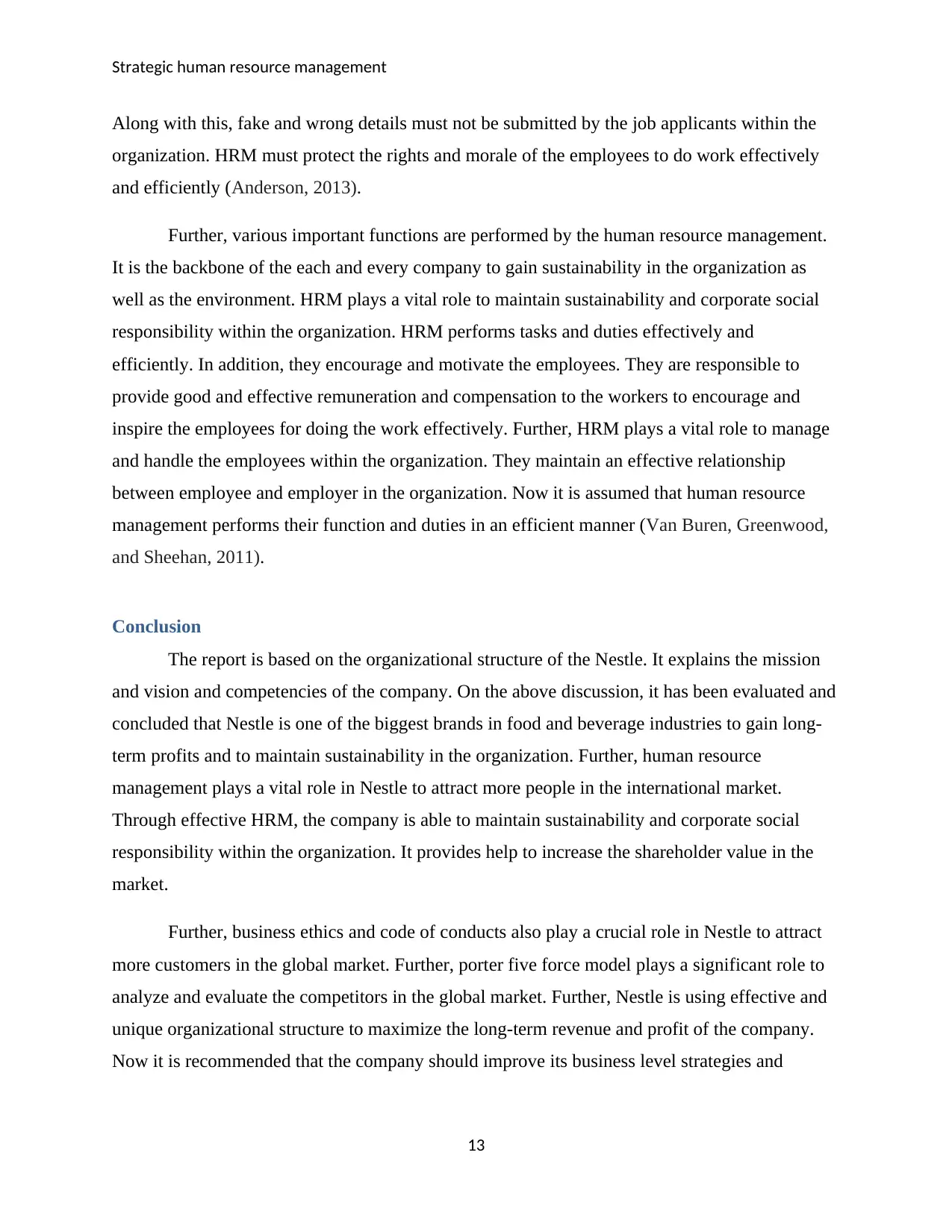
Strategic human resource management
Along with this, fake and wrong details must not be submitted by the job applicants within the
organization. HRM must protect the rights and morale of the employees to do work effectively
and efficiently (Anderson, 2013).
Further, various important functions are performed by the human resource management.
It is the backbone of the each and every company to gain sustainability in the organization as
well as the environment. HRM plays a vital role to maintain sustainability and corporate social
responsibility within the organization. HRM performs tasks and duties effectively and
efficiently. In addition, they encourage and motivate the employees. They are responsible to
provide good and effective remuneration and compensation to the workers to encourage and
inspire the employees for doing the work effectively. Further, HRM plays a vital role to manage
and handle the employees within the organization. They maintain an effective relationship
between employee and employer in the organization. Now it is assumed that human resource
management performs their function and duties in an efficient manner (Van Buren, Greenwood,
and Sheehan, 2011).
Conclusion
The report is based on the organizational structure of the Nestle. It explains the mission
and vision and competencies of the company. On the above discussion, it has been evaluated and
concluded that Nestle is one of the biggest brands in food and beverage industries to gain long-
term profits and to maintain sustainability in the organization. Further, human resource
management plays a vital role in Nestle to attract more people in the international market.
Through effective HRM, the company is able to maintain sustainability and corporate social
responsibility within the organization. It provides help to increase the shareholder value in the
market.
Further, business ethics and code of conducts also play a crucial role in Nestle to attract
more customers in the global market. Further, porter five force model plays a significant role to
analyze and evaluate the competitors in the global market. Further, Nestle is using effective and
unique organizational structure to maximize the long-term revenue and profit of the company.
Now it is recommended that the company should improve its business level strategies and
13
Along with this, fake and wrong details must not be submitted by the job applicants within the
organization. HRM must protect the rights and morale of the employees to do work effectively
and efficiently (Anderson, 2013).
Further, various important functions are performed by the human resource management.
It is the backbone of the each and every company to gain sustainability in the organization as
well as the environment. HRM plays a vital role to maintain sustainability and corporate social
responsibility within the organization. HRM performs tasks and duties effectively and
efficiently. In addition, they encourage and motivate the employees. They are responsible to
provide good and effective remuneration and compensation to the workers to encourage and
inspire the employees for doing the work effectively. Further, HRM plays a vital role to manage
and handle the employees within the organization. They maintain an effective relationship
between employee and employer in the organization. Now it is assumed that human resource
management performs their function and duties in an efficient manner (Van Buren, Greenwood,
and Sheehan, 2011).
Conclusion
The report is based on the organizational structure of the Nestle. It explains the mission
and vision and competencies of the company. On the above discussion, it has been evaluated and
concluded that Nestle is one of the biggest brands in food and beverage industries to gain long-
term profits and to maintain sustainability in the organization. Further, human resource
management plays a vital role in Nestle to attract more people in the international market.
Through effective HRM, the company is able to maintain sustainability and corporate social
responsibility within the organization. It provides help to increase the shareholder value in the
market.
Further, business ethics and code of conducts also play a crucial role in Nestle to attract
more customers in the global market. Further, porter five force model plays a significant role to
analyze and evaluate the competitors in the global market. Further, Nestle is using effective and
unique organizational structure to maximize the long-term revenue and profit of the company.
Now it is recommended that the company should improve its business level strategies and
13
Paraphrase This Document
Need a fresh take? Get an instant paraphrase of this document with our AI Paraphraser
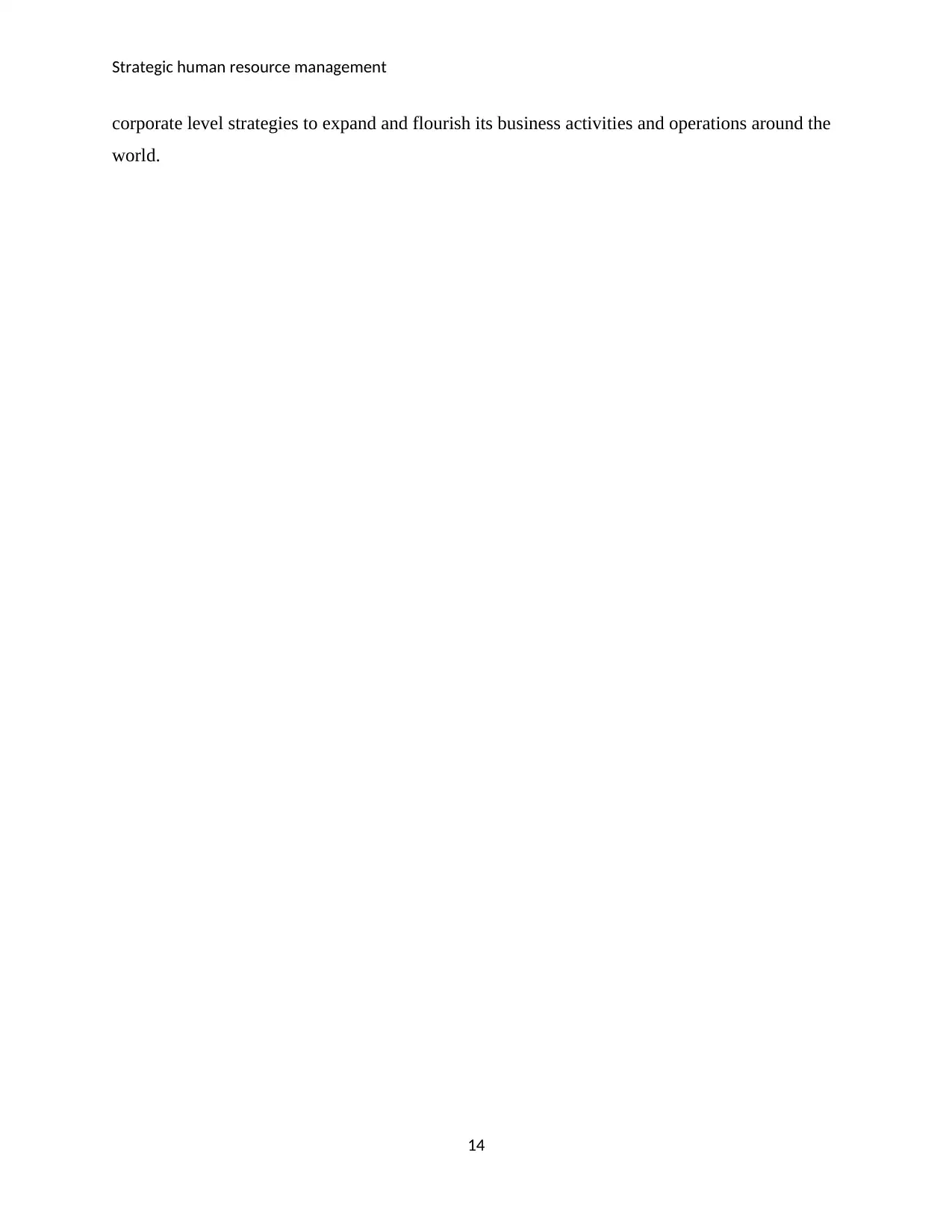
Strategic human resource management
corporate level strategies to expand and flourish its business activities and operations around the
world.
14
corporate level strategies to expand and flourish its business activities and operations around the
world.
14
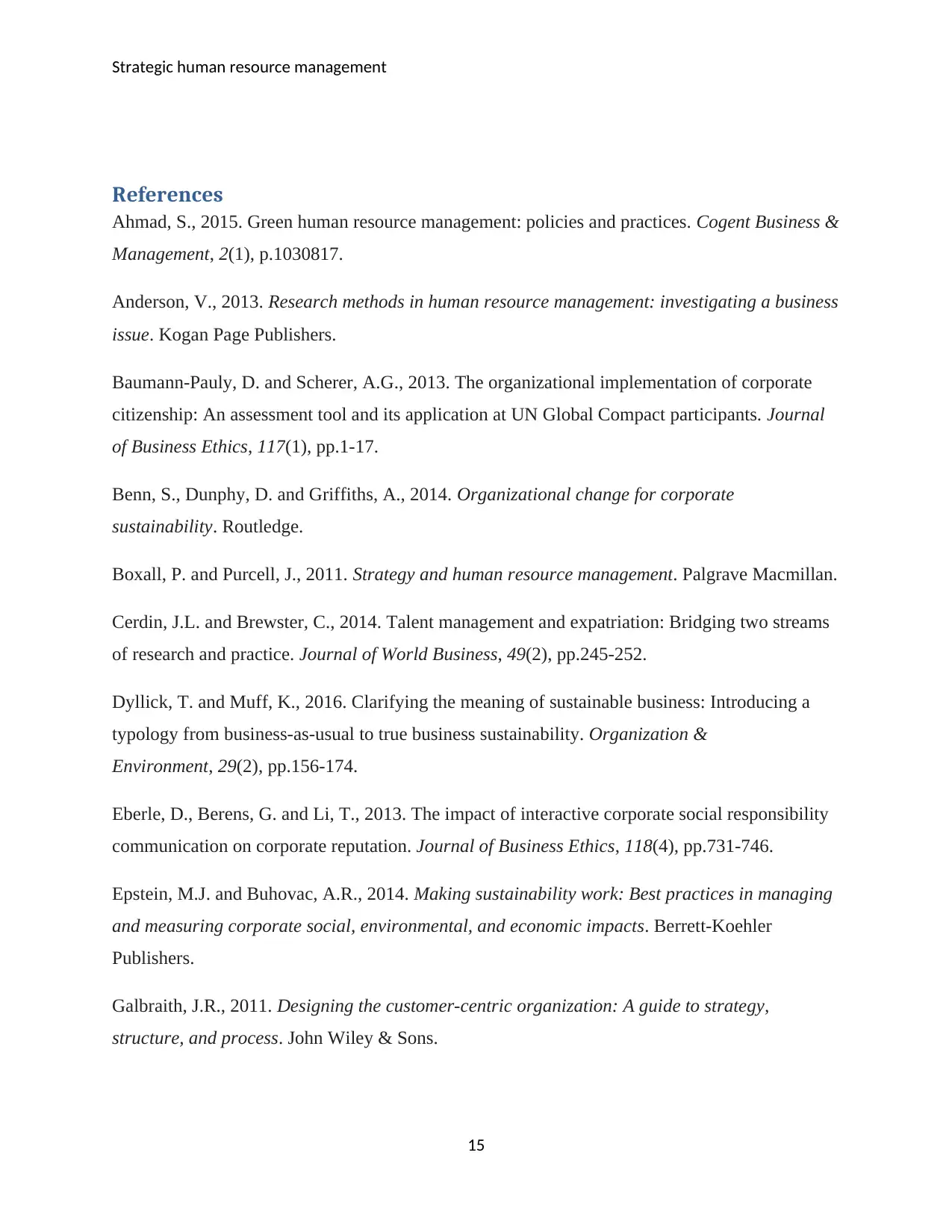
Strategic human resource management
References
Ahmad, S., 2015. Green human resource management: policies and practices. Cogent Business &
Management, 2(1), p.1030817.
Anderson, V., 2013. Research methods in human resource management: investigating a business
issue. Kogan Page Publishers.
Baumann-Pauly, D. and Scherer, A.G., 2013. The organizational implementation of corporate
citizenship: An assessment tool and its application at UN Global Compact participants. Journal
of Business Ethics, 117(1), pp.1-17.
Benn, S., Dunphy, D. and Griffiths, A., 2014. Organizational change for corporate
sustainability. Routledge.
Boxall, P. and Purcell, J., 2011. Strategy and human resource management. Palgrave Macmillan.
Cerdin, J.L. and Brewster, C., 2014. Talent management and expatriation: Bridging two streams
of research and practice. Journal of World Business, 49(2), pp.245-252.
Dyllick, T. and Muff, K., 2016. Clarifying the meaning of sustainable business: Introducing a
typology from business-as-usual to true business sustainability. Organization &
Environment, 29(2), pp.156-174.
Eberle, D., Berens, G. and Li, T., 2013. The impact of interactive corporate social responsibility
communication on corporate reputation. Journal of Business Ethics, 118(4), pp.731-746.
Epstein, M.J. and Buhovac, A.R., 2014. Making sustainability work: Best practices in managing
and measuring corporate social, environmental, and economic impacts. Berrett-Koehler
Publishers.
Galbraith, J.R., 2011. Designing the customer-centric organization: A guide to strategy,
structure, and process. John Wiley & Sons.
15
References
Ahmad, S., 2015. Green human resource management: policies and practices. Cogent Business &
Management, 2(1), p.1030817.
Anderson, V., 2013. Research methods in human resource management: investigating a business
issue. Kogan Page Publishers.
Baumann-Pauly, D. and Scherer, A.G., 2013. The organizational implementation of corporate
citizenship: An assessment tool and its application at UN Global Compact participants. Journal
of Business Ethics, 117(1), pp.1-17.
Benn, S., Dunphy, D. and Griffiths, A., 2014. Organizational change for corporate
sustainability. Routledge.
Boxall, P. and Purcell, J., 2011. Strategy and human resource management. Palgrave Macmillan.
Cerdin, J.L. and Brewster, C., 2014. Talent management and expatriation: Bridging two streams
of research and practice. Journal of World Business, 49(2), pp.245-252.
Dyllick, T. and Muff, K., 2016. Clarifying the meaning of sustainable business: Introducing a
typology from business-as-usual to true business sustainability. Organization &
Environment, 29(2), pp.156-174.
Eberle, D., Berens, G. and Li, T., 2013. The impact of interactive corporate social responsibility
communication on corporate reputation. Journal of Business Ethics, 118(4), pp.731-746.
Epstein, M.J. and Buhovac, A.R., 2014. Making sustainability work: Best practices in managing
and measuring corporate social, environmental, and economic impacts. Berrett-Koehler
Publishers.
Galbraith, J.R., 2011. Designing the customer-centric organization: A guide to strategy,
structure, and process. John Wiley & Sons.
15

Strategic human resource management
Gold, S. and Heikkurinen, P., 2013. Corporate responsibility, supply chain management and
strategy: In search of new perspectives for sustainable food production. Journal of Global
Responsibility, 4(2), pp.276-291.
Hartmann, M., 2011. Corporate social responsibility in the food sector. European Review of
Agricultural Economics, 38(3), pp.297-324.
Jabbour, C.J.C., de Sousa Jabbour, A.B.L., Govindan, K., Teixeira, A.A. and de Souza Freitas,
W.R., 2013. Environmental management and operational performance in automotive companies
in Brazil: the role of human resource management and lean manufacturing. Journal of Cleaner
Production, 47, pp.129-140.
Jackson, S.E., Schuler, R.S. and Jiang, K., 2014. An aspirational framework for strategic human
resource management. Academy of Management Annals, 8(1), pp.1-56.
Kapferer, J.N., 2012. The new strategic brand management: Advanced insights and strategic
thinking. Kogan page publishers.
Kehoe, R.R. and Wright, P.M., 2013. The impact of high-performance human resource practices
on employees’ attitudes and behaviors. Journal of management, 39(2), pp.366-391.
Khan, R.S., Grigor, J., Winger, R. and Win, A., 2013. Functional food product development–
Opportunities and challenges for food manufacturers. Trends in food science &
technology, 30(1), pp.27-37.
Kim, W.G. and Brymer, R.A., 2011. The effects of ethical leadership on manager job
satisfaction, commitment, behavioral outcomes, and firm performance. International Journal of
Hospitality Management, 30(4), pp.1020-1026.
Kiran, R. and Sharma, A., 2011. Corporate social responsibility: a corporate strategy for new
business opportunities. Journal of international business ethics, 4(1), p.10.
Li, T., 2015. Nestle Employee Recruitment Research. International Journal of Business and
Social Science, 6(4).
16
Gold, S. and Heikkurinen, P., 2013. Corporate responsibility, supply chain management and
strategy: In search of new perspectives for sustainable food production. Journal of Global
Responsibility, 4(2), pp.276-291.
Hartmann, M., 2011. Corporate social responsibility in the food sector. European Review of
Agricultural Economics, 38(3), pp.297-324.
Jabbour, C.J.C., de Sousa Jabbour, A.B.L., Govindan, K., Teixeira, A.A. and de Souza Freitas,
W.R., 2013. Environmental management and operational performance in automotive companies
in Brazil: the role of human resource management and lean manufacturing. Journal of Cleaner
Production, 47, pp.129-140.
Jackson, S.E., Schuler, R.S. and Jiang, K., 2014. An aspirational framework for strategic human
resource management. Academy of Management Annals, 8(1), pp.1-56.
Kapferer, J.N., 2012. The new strategic brand management: Advanced insights and strategic
thinking. Kogan page publishers.
Kehoe, R.R. and Wright, P.M., 2013. The impact of high-performance human resource practices
on employees’ attitudes and behaviors. Journal of management, 39(2), pp.366-391.
Khan, R.S., Grigor, J., Winger, R. and Win, A., 2013. Functional food product development–
Opportunities and challenges for food manufacturers. Trends in food science &
technology, 30(1), pp.27-37.
Kim, W.G. and Brymer, R.A., 2011. The effects of ethical leadership on manager job
satisfaction, commitment, behavioral outcomes, and firm performance. International Journal of
Hospitality Management, 30(4), pp.1020-1026.
Kiran, R. and Sharma, A., 2011. Corporate social responsibility: a corporate strategy for new
business opportunities. Journal of international business ethics, 4(1), p.10.
Li, T., 2015. Nestle Employee Recruitment Research. International Journal of Business and
Social Science, 6(4).
16
Secure Best Marks with AI Grader
Need help grading? Try our AI Grader for instant feedback on your assignments.
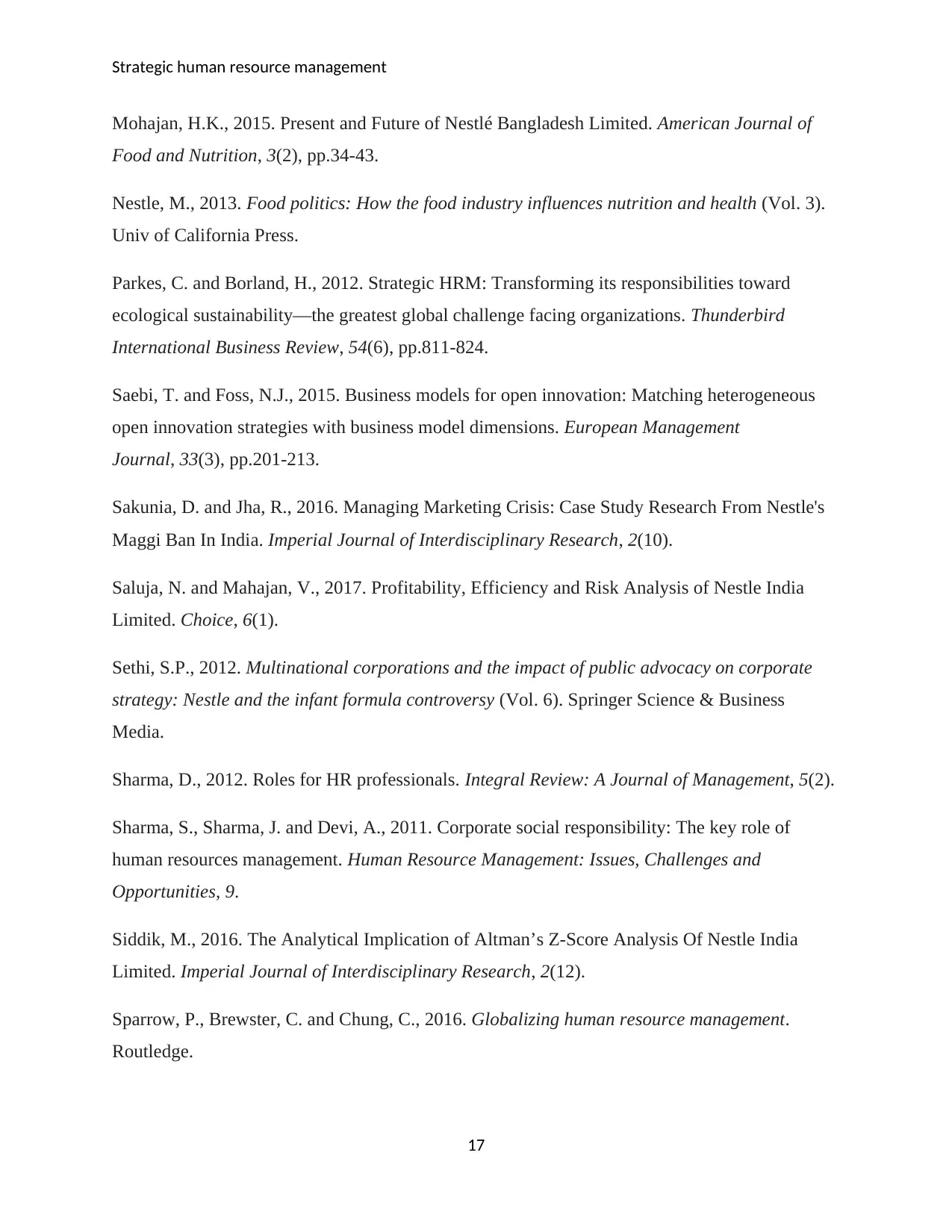
Strategic human resource management
Mohajan, H.K., 2015. Present and Future of Nestlé Bangladesh Limited. American Journal of
Food and Nutrition, 3(2), pp.34-43.
Nestle, M., 2013. Food politics: How the food industry influences nutrition and health (Vol. 3).
Univ of California Press.
Parkes, C. and Borland, H., 2012. Strategic HRM: Transforming its responsibilities toward
ecological sustainability—the greatest global challenge facing organizations. Thunderbird
International Business Review, 54(6), pp.811-824.
Saebi, T. and Foss, N.J., 2015. Business models for open innovation: Matching heterogeneous
open innovation strategies with business model dimensions. European Management
Journal, 33(3), pp.201-213.
Sakunia, D. and Jha, R., 2016. Managing Marketing Crisis: Case Study Research From Nestle's
Maggi Ban In India. Imperial Journal of Interdisciplinary Research, 2(10).
Saluja, N. and Mahajan, V., 2017. Profitability, Efficiency and Risk Analysis of Nestle India
Limited. Choice, 6(1).
Sethi, S.P., 2012. Multinational corporations and the impact of public advocacy on corporate
strategy: Nestle and the infant formula controversy (Vol. 6). Springer Science & Business
Media.
Sharma, D., 2012. Roles for HR professionals. Integral Review: A Journal of Management, 5(2).
Sharma, S., Sharma, J. and Devi, A., 2011. Corporate social responsibility: The key role of
human resources management. Human Resource Management: Issues, Challenges and
Opportunities, 9.
Siddik, M., 2016. The Analytical Implication of Altman’s Z-Score Analysis Of Nestle India
Limited. Imperial Journal of Interdisciplinary Research, 2(12).
Sparrow, P., Brewster, C. and Chung, C., 2016. Globalizing human resource management.
Routledge.
17
Mohajan, H.K., 2015. Present and Future of Nestlé Bangladesh Limited. American Journal of
Food and Nutrition, 3(2), pp.34-43.
Nestle, M., 2013. Food politics: How the food industry influences nutrition and health (Vol. 3).
Univ of California Press.
Parkes, C. and Borland, H., 2012. Strategic HRM: Transforming its responsibilities toward
ecological sustainability—the greatest global challenge facing organizations. Thunderbird
International Business Review, 54(6), pp.811-824.
Saebi, T. and Foss, N.J., 2015. Business models for open innovation: Matching heterogeneous
open innovation strategies with business model dimensions. European Management
Journal, 33(3), pp.201-213.
Sakunia, D. and Jha, R., 2016. Managing Marketing Crisis: Case Study Research From Nestle's
Maggi Ban In India. Imperial Journal of Interdisciplinary Research, 2(10).
Saluja, N. and Mahajan, V., 2017. Profitability, Efficiency and Risk Analysis of Nestle India
Limited. Choice, 6(1).
Sethi, S.P., 2012. Multinational corporations and the impact of public advocacy on corporate
strategy: Nestle and the infant formula controversy (Vol. 6). Springer Science & Business
Media.
Sharma, D., 2012. Roles for HR professionals. Integral Review: A Journal of Management, 5(2).
Sharma, S., Sharma, J. and Devi, A., 2011. Corporate social responsibility: The key role of
human resources management. Human Resource Management: Issues, Challenges and
Opportunities, 9.
Siddik, M., 2016. The Analytical Implication of Altman’s Z-Score Analysis Of Nestle India
Limited. Imperial Journal of Interdisciplinary Research, 2(12).
Sparrow, P., Brewster, C. and Chung, C., 2016. Globalizing human resource management.
Routledge.
17

Strategic human resource management
Spicka, J., 2013. The competitive environment in the dairy industry and its impact on the food
industry. Agris on-line Papers in Economics and Informatics, 5(2), p.89.
Stahl, G., Björkman, I., Farndale, E., Morris, S.S., Paauwe, J., Stiles, P., Trevor, J. and Wright,
P., 2012. Six principles of effective global talent management. Sloan Management
Review, 53(2), pp.25-42.
Stampfl, G. and Prügl, R., 2011. Business models in context: conceptualizing the environment of
business models. In Academy of Management Annual Meeting.
Van Buren, H.J., Greenwood, M. and Sheehan, C., 2011. Strategic human resource management
and the decline of employee focus. Human Resource Management Review, 21(3), pp.209-219.
Wheelen, T.L. and Hunger, J.D., 2011. Concepts in strategic management and business policy.
Pearson Education India.
18
Spicka, J., 2013. The competitive environment in the dairy industry and its impact on the food
industry. Agris on-line Papers in Economics and Informatics, 5(2), p.89.
Stahl, G., Björkman, I., Farndale, E., Morris, S.S., Paauwe, J., Stiles, P., Trevor, J. and Wright,
P., 2012. Six principles of effective global talent management. Sloan Management
Review, 53(2), pp.25-42.
Stampfl, G. and Prügl, R., 2011. Business models in context: conceptualizing the environment of
business models. In Academy of Management Annual Meeting.
Van Buren, H.J., Greenwood, M. and Sheehan, C., 2011. Strategic human resource management
and the decline of employee focus. Human Resource Management Review, 21(3), pp.209-219.
Wheelen, T.L. and Hunger, J.D., 2011. Concepts in strategic management and business policy.
Pearson Education India.
18
1 out of 18
Related Documents
Your All-in-One AI-Powered Toolkit for Academic Success.
+13062052269
info@desklib.com
Available 24*7 on WhatsApp / Email
![[object Object]](/_next/static/media/star-bottom.7253800d.svg)
Unlock your academic potential
© 2024 | Zucol Services PVT LTD | All rights reserved.





